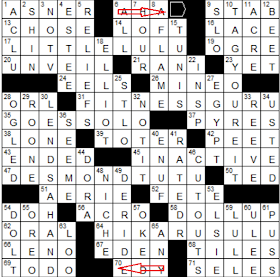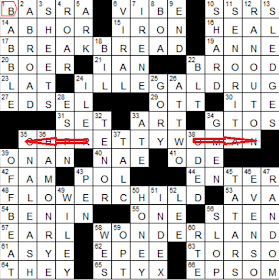So, what are cheater squares?
They're symmetrically placed black squares which can be removed without affecting the total word count of a grid.
Let's look at this ?U?U puzzle Argyle and I made last November:
The
two black squares the red arrows point to: the one to the right of AHA
(6A) & the one to the the left of EDY (7D), are cheaters. The word
count here is 76. Total black squares: 36. Average word length: 4.97
(letters)
Now look at our original cheater-less submission:
No
black squares to the right of 6A or to the left of 70A. Total word
count here is still 76. Total black squares 34. Average word length:
5.03 (letters).
The reason we had to add two cheaters is
that Rich thought ELUL (7D) is not a Monday entry. Adding cheaters
smooths out the fill considerably.
Cheaters are normally
added to the grid in the filling process. The ones beside theme entries,
like these two to the left and right of OH PRETTY WOMAN (35A, the very middle 13-letter entry), should not be
counted as cheaters. I put them in the grid designing process. I had
other alternatives, but I didn't like the abundance of 3's they resulted
and preferred these stacked 8's & 6's in the corner.
As I said yesterday, cheaters are not bad. They give constructors cleaner fill. To me, cheater-less grids look pretty. Plus, you get slightly longer, thus interesting words.
John Lampkin, Don G and today's co-constructor Bruce Venzke do not like cheaters in their grids. It takes discipline and hard work eliminating cheaters. Sometimes it's just not possible avoiding them, like John's grid yesterday.
John Lampkin, Don G and today's co-constructor Bruce Venzke do not like cheaters in their grids. It takes discipline and hard work eliminating cheaters. Sometimes it's just not possible avoiding them, like John's grid yesterday.



Thanks for the clear lesson on the cheater squares.
ReplyDeleteI often don't notice cheater squares, and don't think they are a bad thing. In fact, Rich actually calles them "helper" squares, because they do help make better fill. I remember a John Lampkin puzzle that seemed to have lots of cheater squares. But when the grid was finished, it was all about "snakes", and the cheaters were put in on purpose, to look like SNAKES squiggling across the grid. Impressive!
ReplyDeleteThanks for the explanation, that was interesting.
ReplyDeleteI just had a chance to check our your discussion of "cheaters," C.C. Am still not sure I totally understand it, and will look at it again more carefully when I have more time this afternoon. But it reminds me again how complex and difficult constructing puzzles is. Before I joined the Corner, I never even noticed the grid. Now I appreciate the art involved in its symmetry and other features. So, many thanks for this explanation.
ReplyDeletea-ha! great explanation
ReplyDeleteCC,
ReplyDeleteThank you for the great explanation of Cheater Squares. You are a good teacher. Now if I can just remember it! Would you consider posting it under one of the links on the right side of the blog?
Bob,
ReplyDeleteThis post is now under Olio on the blog front page. Thanks for getting me started.
CC,
ReplyDeleteYou're welcome. I was surprised how many bloggers didn't understand cheater squares either, so many of us learned from you again. But I think it shows how complicated constructing a crossword puzzle is. Thank you for posting it under Olio for our future reference.